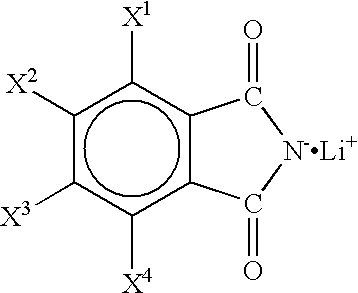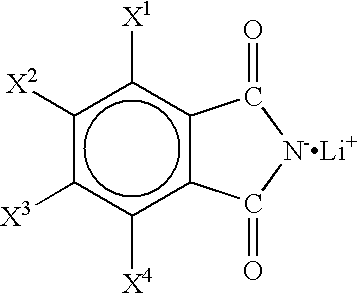Non-aqueous electrolyte and non-aqueous electrolyte cell
a technology of electrolyte and non-aqueous electrolyte, which is applied in the field of non-aqueous electrolyte, can solve the problems of battery capacity deterioration, capacity deterioration, and battery capacity deterioration, and achieve excellent storage properties, improve storage properties, and improve capacity.
- Summary
- Abstract
- Description
- Claims
- Application Information
AI Technical Summary
Benefits of technology
Problems solved by technology
Method used
Image
Examples
example 2
Batteries G1 to K1 and G2 to K2, and a battery 2 of a comparative example were prepared in the same manner as in Example 1 except that non-aqueous electrolytes containing a first solute and a second solute as shown in Tables 3 and 4 dissolved in concentrations as shown in Tables 3 and 4 were used, and the charge / discharge test was carried out. Here, in Tables 3 and 4, LiTFPB represents LiB(C.sub.6 H.sub.3 (CF.sub.3).sub.2).sub.4 (lithium tetrakis(3,5-bis(trifluoromethyl)phenyl)borate). The results are shown in Tables 3 and 4.
TABLE 4
As shown in Tables 3 and 4, The batteries G1 to K1 and G2 to K2 using the non-aqueous electrolyte of the present invention containing as a solute the lithium salt represented by the general formula (1) or the lithium salt represented by the general formula (2) have higher capacity maintenance rates than that of the battery 2 of the comparative example. Among these, the batteries containing a non-aqueous electrolyte using the above lithium salt together wi...
example 3
In this example, coin-type batteries having the structure shown in FIG. 1 are prepared in the following manner.
Electrolytic manganese dioxide which had been thermally treated at 400.degree. C., carbon black as a conducting agent and a fluorocarbon polymer as a binder were mixed in a weight ratio of 85:8:7 to give a positive electrode material mixture. This positive electrode material mixture was pressed at 2 ton / cm.sup.2 and molded into a pellet having 16 mm diameter, and then dried at 250.degree. C. in a dried atmosphere containing 1% or less moisture, thereby giving a positive electrode.
As the negative electrode, metal lithium was used.
Propylene carbonate and 1,2-dimethoxyethane were mixed in a volume ratio of 6:4 to give the solvent for the non-aqueous electrolyte. In this solvent, the solute as shown in Table 5 or 6 was dissolved in a concentration as shown in Tables 5 or 6 to give a non-aqueous electrolyte.
TABLE 6
Using the above positive electrode, negative electrode and non-aq...
PUM
| Property | Measurement | Unit |
|---|---|---|
| thickness | aaaaa | aaaaa |
| diameter | aaaaa | aaaaa |
| voltage | aaaaa | aaaaa |
Abstract
Description
Claims
Application Information
 Login to View More
Login to View More - R&D
- Intellectual Property
- Life Sciences
- Materials
- Tech Scout
- Unparalleled Data Quality
- Higher Quality Content
- 60% Fewer Hallucinations
Browse by: Latest US Patents, China's latest patents, Technical Efficacy Thesaurus, Application Domain, Technology Topic, Popular Technical Reports.
© 2025 PatSnap. All rights reserved.Legal|Privacy policy|Modern Slavery Act Transparency Statement|Sitemap|About US| Contact US: help@patsnap.com



